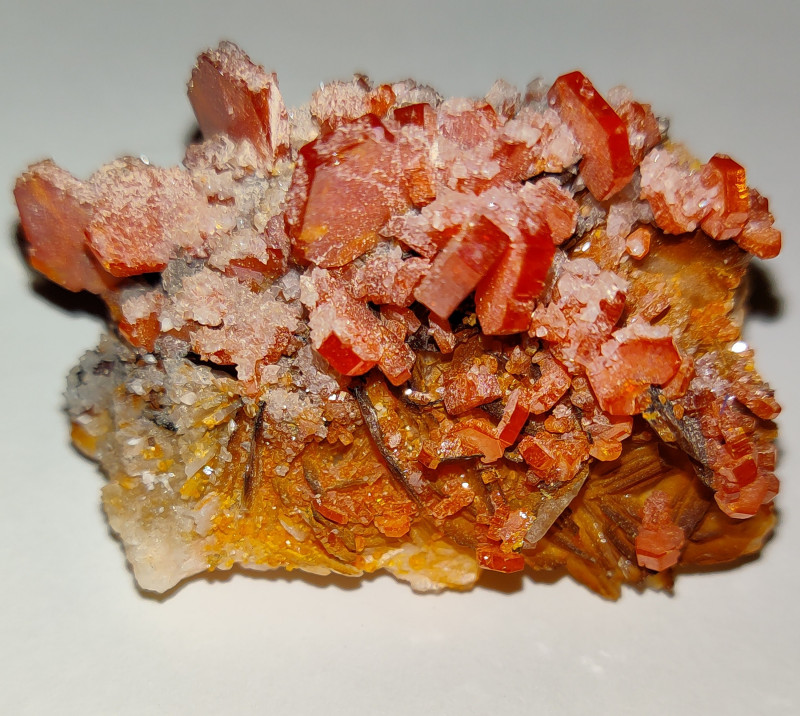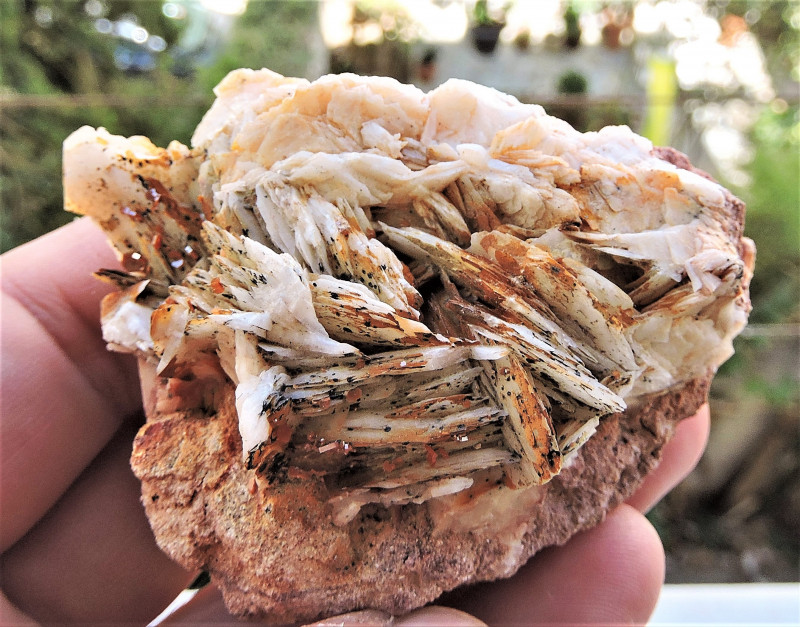
Vanadinite Gemstone: Properties, Meanings, Value & More
 Vanadinite is a gemstone known for its vibrant red and orange coloring. The coloring is so bright, you may wonder: is vanadinite natural? Yep, you can thank Mother Earth for those fiery shades.
Vanadinite is a gemstone known for its vibrant red and orange coloring. The coloring is so bright, you may wonder: is vanadinite natural? Yep, you can thank Mother Earth for those fiery shades.
Is the vanadinite crystal rare? Yes, it’s fairly rare. Facetable vanadinite is even rarer, with under 10 faceted vanadinites currently known.
If you’re interested in learning more before browsing through vanadinite for sale, come along as we discuss vanadinite’s history, meaning, healing powers, and prices. We’ll also touch on whether vanadinite is toxic and how to safely handle it.

About Vanadinite Stone
Vanadinite is a semi-precious gemstone used for both gemstones and industrial applications. Industrially, what is vanadinite used for?
The primary non-gemstone vanadinite uses are for sourcing lead and vanadium metal. In fact, vanadinite is among the main sources of vanadium, alongside carnotite and patrónite.
Astrologically, vanadinite is a beneficial zodiac stone for Aries, Leo, Virgo, and Scorpio. It also vibrates with the number 9 in numerology.
In mineralogy, vanadinite’s luster can be close to that of diamond (adamantine) or amber (resinous). These lusters are rare in stones as heavy as vanadinite, making identification a bit easier.
Speaking of, we’ll discuss more identifying mineral traits next!

Vanadinite Specifications & Characteristics
Vanadinite is a mineral in the apatite group of hexagonal (or pseudohexagonal) phosphates, vanadates, or arsenates. Other minerals in this group that you may know include pyromorphite (Pb5(PO4)3Cl) and mimetite (Pb5(AsO4)3Cl), which each form a series with vanadinite.
The mineral’s formula is Pb5(VO4)3Cl, meaning it’s composed of lead, vanadium, oxygen, and chlorine. The largest component is lead at around 73 percent, with vanadium and oxygen making up around 11 percent and 13 percent, respectively.
This mineral is technically a lead chloro-vanadate. Vanadate minerals contain vanadium, oxygen, and one or more metals. They’re always low on the Mohs mineral hardness scale and usually quite heavy, two traits vanadinite possesses.
Usually, vanadinite forms as stubby, nodular (rounded) or prismatic crystals, sometimes partly hollow and often with a pinacoid termination (flat-faced base). It may also be fibrous, hair-like, acicular (needle-like), or encrusted (as a geode). Rarely, you’ll see rounded, globular masses of vanadinite.

The remaining vanadinite mineral data is listed below:
Mineral family: Apatite group
Mohs hardness: 3-4
Color: Red, reddish-brown, orange, brown, yellow, gray; Rarely white or colorless; Sometimes displays concentric color-zoning
Crystal structure: Hexagonal
Luster: Resinous to sub-adamantine
Transparency: Transparent to opaque
Refractive index: 2.146-2.350
Density: 6.8–7.1
Cleavage: None
Fracture: Uneven to conchoidal
Streak: White to yellow or brownish-yellow
Luminescence: None
Pleochroism: Present but weak in transparent material - dual shades of body color
Next up, what does vanadinite crystal mean?

Vanadinite Meaning & History
Vanadinite crystals symbolize energy, exploration, and creativity. Some even call it a “caffeine crystal,” claiming it helps you focus and flow at work so you can daydream and relax at home.
This crystal’s chemical composition also has ties to mythology. The main component, vanadium, was named after Vanadis.
Vanadis, also known as Freyja (or Freya), is the Norse goddess of beauty, love, earth, and fertility. However, she was also a fierce warrior and the first Valkyrie, a group of maidens who Odin would send to “choose the slain” to become citizens of Valhalla after battles.
History
Vanadinite’s name comes from its vanadium content, but it wasn’t the mineral’s first name. The first name was “brown lead,” chosen by Spanish mineralogist Andrés Manuel del Río when he discovered the mineral in 1801.
The mineralogist was working for the Royal College of Mines in Mexico City at the time. While organizing the college’s mineral collection, he found a stone labeled “plumo rojo del Zimapán” (Spanish for “red lead from Zimapán).
Del Río knew the mineral contained lead because of its brown and red coloring, and the original deposit was subsequently nicknamed “plombo rojo” (Spanish for “red lead”).
Another correct hypothesis Del Río made was that the mineral contained a new element. He named the element "panchromium" (for its numerous colors), then "erythronium" (after the Greek eruthronion, meaning "red-flowered orchid" for its blood-red color).
Del Río had his analysis checked by German scientist Alexander von Humbolt who, unfortunately (and incorrectly), told him the element was a type of chromium.
That assumption changed in 1830 when Swedish chemist Nils Gabriel Sefström discovered a new metal element and named it vanadium. Eventually, vanadinite was rediscovered in 1838 in Hidalgo, Mexico. Mineralogists put two and two together and realized vanadium was the new element in the stone, thus renaming it vanadinite.
Other proposed names for the stone were “johnstonite” and “lead vanadate,” but the vanadinite name has stuck.
The popularity of vanadinite, however, didn’t start to rise until gorgeous, well-formed crystals were found in Morocco.
Since then, vanadinite has also gained a reputation in the crystal healing community.

Vanadinite Healing Properties
Like all gemstones, vanadinite can be used as a healing stone for physical, emotional, and spiritual wellness. Its color also influences some of its healing powers. Red vanadinite stones, like all red gemstones, bring you warmth, love, and positive vibes.
Meanwhile, orange vanadinite crystals join other orange gemstones in boosting intellect and creativity.
Now, what about vanadinite benefits for physical and emotional healing?
Physical Healing
Perhaps unsurprisingly, vanadinite’s primary uses in physical healing are boosting energy, endurance, and longevity. It’s also said to help with:
Iron absorption
Breathing difficulties
Congestion
Bladder issues
Emotional Healing
Emotionally, vanadinite is great for leaving behind habits or mindsets that don’t serve you anymore. From there, it’s said to help you restructure your perspective, throwing in some creativity and motivation.
This makes it especially helpful for those with jobs that require more focus and spark, like copywriters, authors, or graphic designers, to name a few.
Chakra Healing
Chakra healing involves balancing energy centers (chakras) to resolve negative symptoms associated with blockages.
Vanadinite crystals are chakra stones for the sacral chakra, opening this energy center to allow for higher libido, passion, and inspiration.
 Image credit: Rob Lavinsky, iRocks.com – CC-BY-SA-3.0
Image credit: Rob Lavinsky, iRocks.com – CC-BY-SA-3.0
Vanadinite Gemstone Properties
Experts determine vanadinite’s value by looking at its color, cut, clarity, and carat weight. You don’t have to be an expert to know what traits to keep an eye out for, though.
Color
Though vanadinite can be gray, brown, yellow, or even (rarely) colorless, the most valuable specimens have vibrant red or orange-red coloring.
Vanadinite’s color comes from its vanadium content. Vanadium gives minerals bright, beautiful colors, and the exact colors depend on the element’s valence electrons. Therefore, vanadium with different numbers of valence electrons can produce red, yellow, or brown vanadinite.
Cut
Vanadinite is hardly ever seen as faceted gemstones, giving these rarities top-dollar prices. More often, you’ll see it sold raw (uncut) or cut into small crystals. Raw vanadinite crystals, especially encrusted geode types, are popular for jewelry.
Clarity
Clarity describes the amount of visible inclusions in a stone. While visible inclusions usually lower value, the most common inclusion in vanadinite (barite) may increase its value. Some inclusions and internal fractures can even produce a different reflected light color in vanadinite.
Carat Weight & Size
Vanadinite is almost always small, with Moroccan specimens being the exception. Before Moroccan finds, the crystals were only about 0.5 in (1.27 cm) on average. Morocco has produced stunning vanadinite crystals several inches long.
Faceted vanadinites are always under 1 carat.
Before it can be cut or measured properly, how does vanadinite form in the first place?

Vanadinite Formation & Sources
Vanadinite is a secondary mineral, meaning it forms when primary minerals are transformed by chemicals, weathering, or other factors. In vanadinite’s case, the primary materials are lead minerals that undergo oxidation, turning into vanadinite.
Because of the need for lead minerals and oxidation conditions, vanadinite is only found in arid regions. This partly contributes to its rarity.
You’ll most often see vanadinite forming beside the lead sulfide mineral galena. Other minerals commonly found with vanadinite are barite, wulfenite, and limonite.
Mining Locations
Though Mexico was the first source of vanadinite, Morocco has since produced many large, red, and world-famous vanadinite crystals.
There are over 400 vanadinite mines worldwide, so we won’t list them all. Instead, here are the significant mines (besides Mexico and Morocco):
Argentina
Arizona, USA
Australia
Austria
Italy
Namibia
New Mexico, USA
Russia
Scotland
Tunisia
As we start to wrap up, let’s discuss vanadinite’s price per gram (and carat).

Vanadinite Price & Value
The highest vanadinite price per carat ranges come from faceted gems. These rarities range from around $115-$680 per carat (or $575-$3400 per gram). Keep in mind, these stones will be small, as vanadinite is a dense mineral.
Prices for rough vanadinite are much more affordable, ranging from about $10-$80 each at wholesale prices. The highest-priced options are vanadinite rough with barite, fetching $500 to $700.
Vanadinite pendants start at around $20 and can reach upwards of $300, though most are around $50 to $150.
Vanadinite Care and Maintenance
Since it’s a lead mineral, you may wonder: is vanadinite toxic? It can be. If you inhale fibers from the stone, it’s very poisonous and possibly deadly.
So, how do you handle vanadinite? If you have a rough specimen, it’s best to keep it as decor and avoid cutting or breaking it down in any way. The safest type of vanadinite to handle is polished or fashioned stones, which don’t pose a risk of releasing fibers unless you start scratching or crushing them.
That said, putting vanadinite in water and drinking it is also dangerous, so drinking an elixir with vanadinite in it is a no-no.
Now, onto gemstone care.
Because of its softness, it’s best to choose vanadinite jewelry with protective settings to prevent scratches.
You can safely clean polished vanadinite specimens by using a compressed air duster (from a slight distance) or wiping the stone with a dust-free, microfiber cloth.
Get Hyped with Vanadinite!
Vanadinite’s fiery red hues perfectly reflect its benefits of energizing and motivating you to get stuff done. Whether you need a creativity boost, some extra focus, or just a sign that you should start that passion project, vanadinite is the stone for you!
Search the Gemstone Encyclopedia
Related Auctions
Related Articles
Originally the Birthstones or gemstones were associated with a zodiac sign or the month of a individuals birth. Find out what your stone is and view the stones we have for sale
8th Feb 2021
There are dozens of quartz and chalcedony gems with various colors and patterns. Learn all about quartz properties and every type of quartz, from amethyst and agate to plasma and phantom quartz!
15th Oct 2020
Hackmanite is a pink to violet sodalite gem known for its unique color-change and luminescence. Learn why hackmanite is special, from its rare qualities to the types of hackmanite jewelry available.
28th Mar 2018
Latest Articles
Catapleiite is a lesser-known mineral and rare gemstone often found as stunning tabular rosettes near other rare stones. Discover the history, prices, benefits, and properties of catapleiite!
28th Apr 2025
Yugawaralite is a rare colorless, white, or pinkish zeolite crystal named for its discovery in Yugawara, Japan. Here we uncover the multifaceted history, properties, prices, and uses of yugawaralite.
24th Mar 2025
Simpsonite is a lesser-known mineral known on the gem market for its durability, yellow-orange color, and rarity. Discover all the properties, uses, prices, and history of simpsonite.
3rd Mar 2025
Article Categories
How To's is where you will find helpful articles from gem Rock Auctions on how to cut gemstones, select gemstones and buy gemstones.
9 Articles




